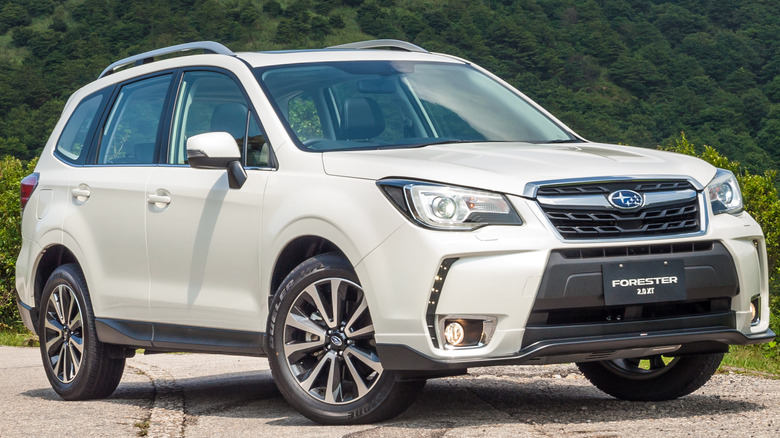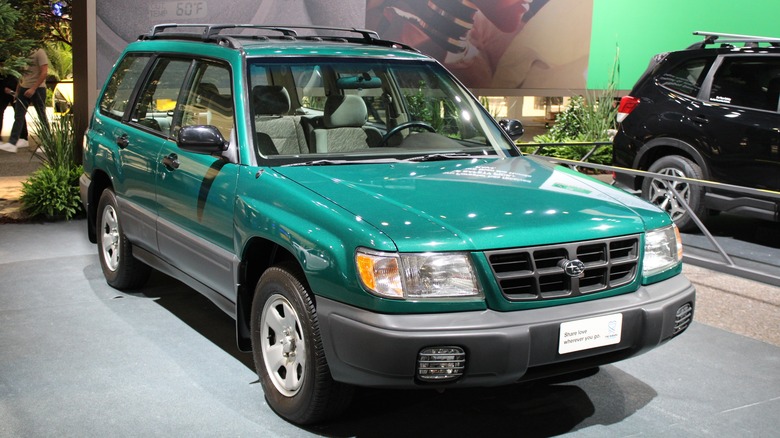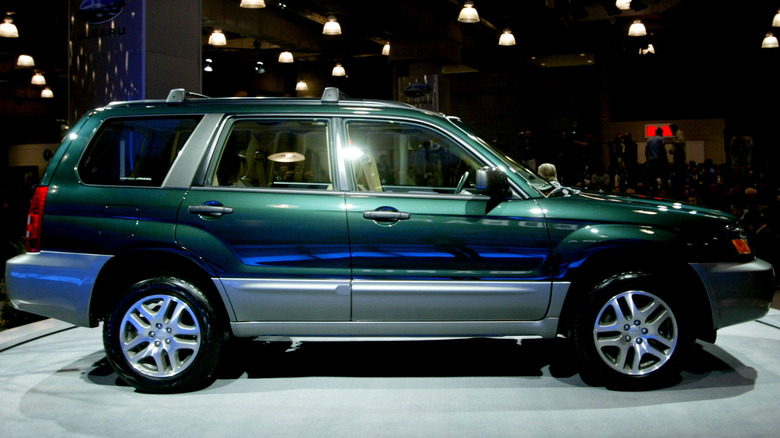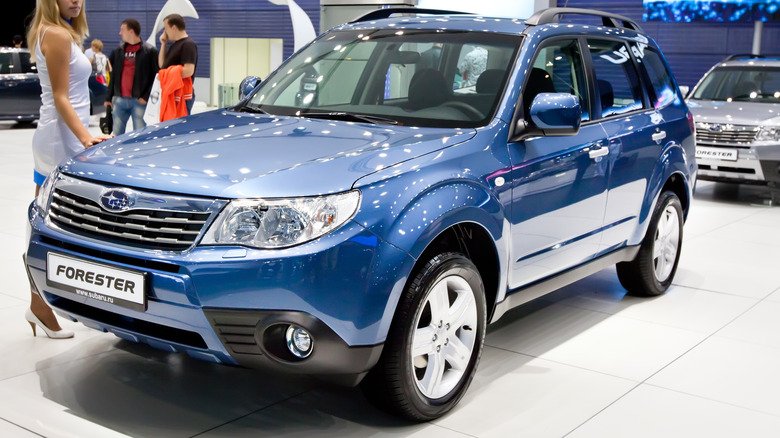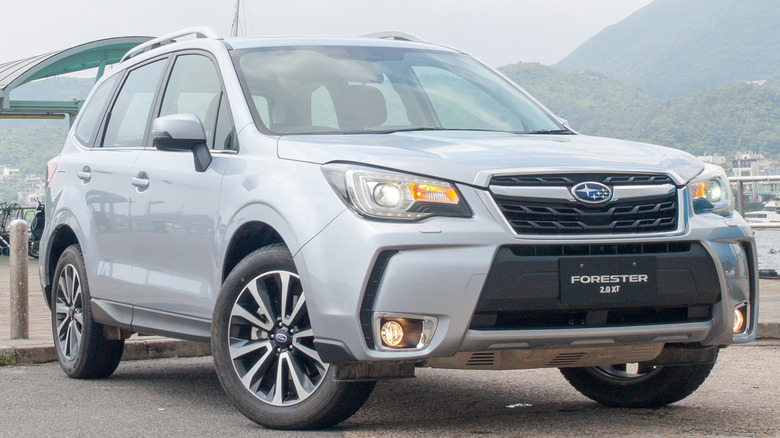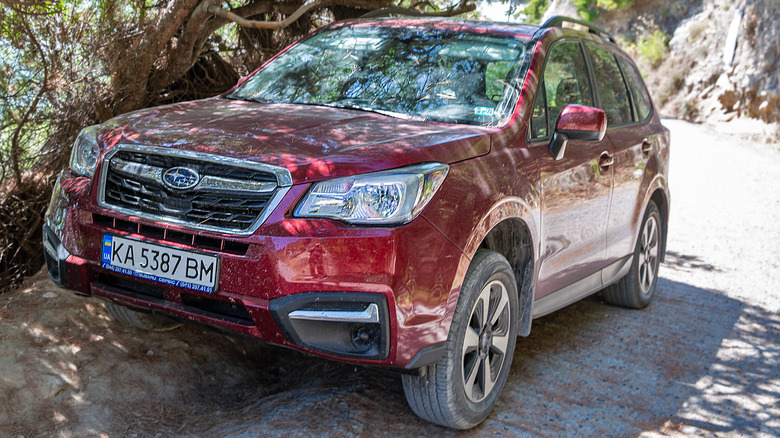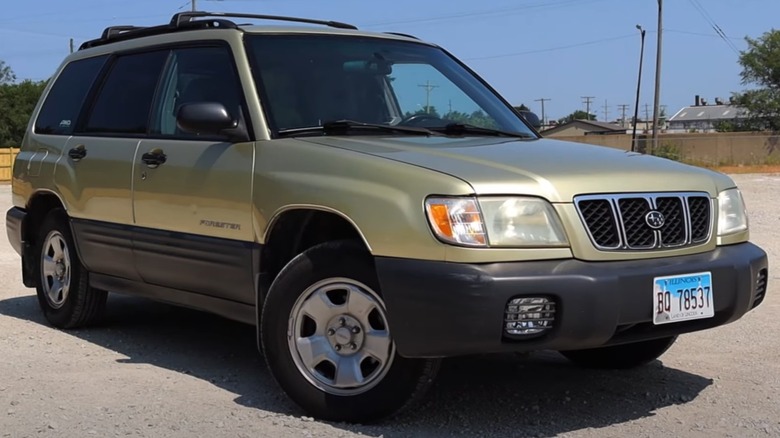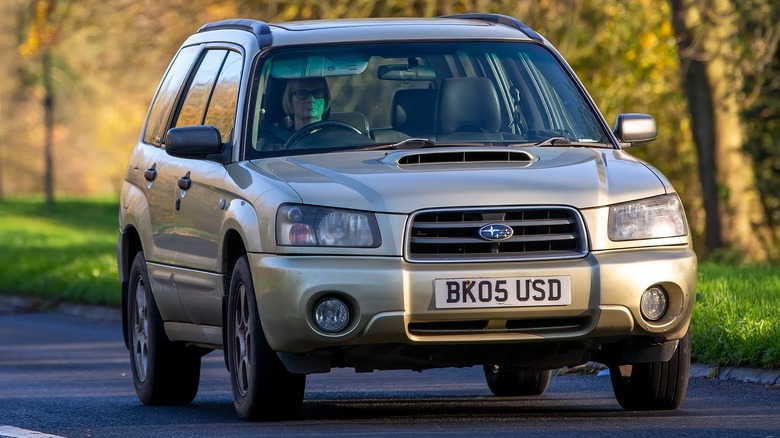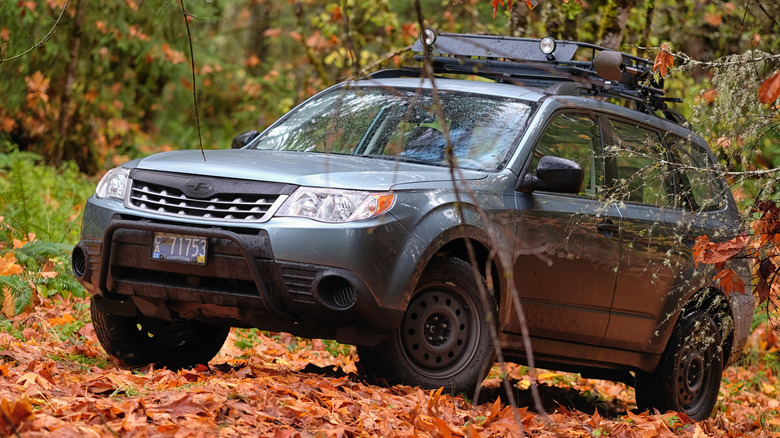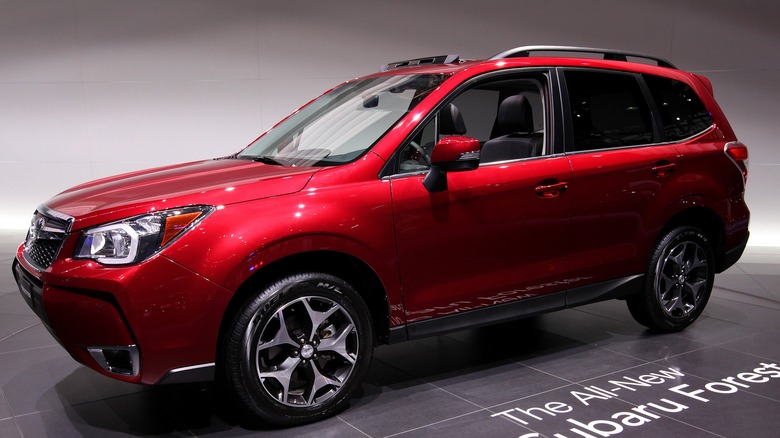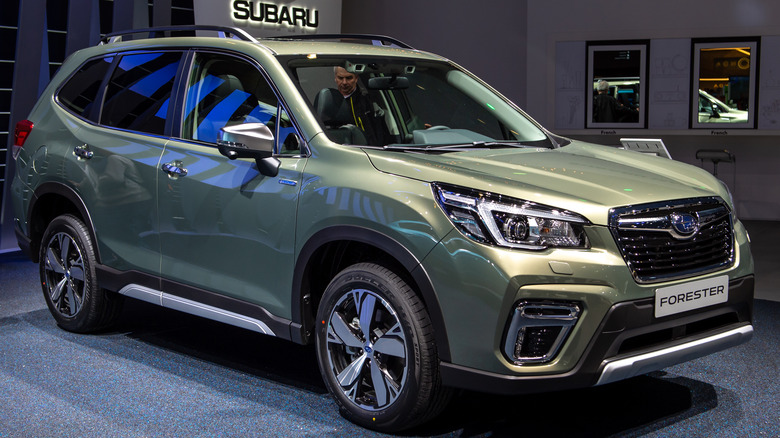5 Of The Best Subaru Forester Years Based On Resale Value (& Which To Avoid)
Subaru first introduced the Forester in 1995 at the Tokyo Motor Show. It was the brand's answer to the booming crossover market and eventually became its SUV, lasting over two decades. Built on the Impreza platform, the Forester offered a unique combination: the agility and handling of a car and the rugged capability of an SUV. Its standard all-wheel drive, a Subaru hallmark, became synonymous with handling any terrain, whether slick highways or dirt roads.
In its lifetime, the Forester has evolved alongside families' needs. It has grown in size, offering more space for adventures and weekend getaways. Its powerful engines ensure effortless highway cruising, while innovative features like the symmetrical all-wheel drive system that became standard in 2009 and EyeSight driver assistance technology prioritize safety and peace of mind. Currently in its sixth generation, the Forester boasts even better features, sleek styling, and advanced driver-assist technologies.
Unfortunately, the path to innovation isn't always smooth. As the Subaru Forester climbed the popularity ladder, there were a few model years that encountered hiccups. Our guide aims to navigate you through the Forester's legacy, highlighting the best years for resale value based on Kelly Blue Book (KBB) pricing and uncovering the ones to approach with caution.
Best: 2000-2002 Subaru Forester
The first-generation Subaru Forester was in production from 1998 to 2002. These models were a parts bin exercise using Subaru's proven Impreza platform. They used a 2.5-liter four-cylinder engine with 165 hp. While it wasn't Subaru's most powerful vehicle, it rivaled Suzuki Grand Vitara's and Honda CR-V's V6 and four-cylinder engines.
For the 2000 to 2002 model years, the Forester ushered in new features, including standard cruise control on the Forester L trim. Additional features included power lock doors, a rear defogger, antilock brakes, air conditioning, power windows, and a cassette stereo. Top trims like the Forester S offered a limited-slip differential, larger tires, and improved interior comforts.
These improvements translated to better owner satisfaction with these later models. Common praise points included affordability, reliable all-weather performance due to AWD, and good used car value. Nowadays, prices for the 2000 to 2002 Foresters range from $2,102 to $3,660, making them attractive used options. While the 2000 to 2001 models didn't have reported recalls, the 2002 Forester models had a transmission parking rod issue, addressed by a free Subaru dealer fix.
Best: 2004-2008 Subaru Forester
Subaru's second-generation Forester was in production from 2003 to 2008. It saw significant improvements, including a new platform that provided a stiffer body for better handling and increased interior space. Notably, the 2007 to 2008 models had a Top Safety Pick IIHS rating. Additional safety features like anti-lock brakes, airbags, traction/stability control, and head restraints contributed to the Forester's NHTSA five-star frontal and side crash rating.
While the 2003 models saw some initial recalls addressed by Subaru through free repairs, later models (2004 to 2008) offered a more refined experience. These models had fewer recalls and complaints than the 2003 models, with common fixes including free control arm replacements, oil flow control valve adjustments, and airbag wiring repairs by Subaru dealerships. Beyond safety, Subaru offered progressive improvements, including introducing a turbocharged XT trim in 2004, which bumped the Forester's horsepower from 165 hp to 210 hp.
Comfort and convenience features also improved, with the 2005 models introducing standard air filtration. This was followed by a general horsepower bump in 2006. Lastly, 2008 introduced stability control as standard equipment. Priced between $3,002 and $6,818, the 2004 to 2008 Foresters offer a compelling value proposition. While they lack the features of their modern counterparts, they still have desirable options like Subaru's Premium Package with automatic climate control, heated amenities, and a panoramic moonroof.
Best: 2009 Subaru Forester
Subaru's third-generation Forester, in production from 2009 to 2013, aimed for a bigger impact. A complete redesign saw it grow three inches longer and an inch taller, offering more space to rival the likes of Mitsubishi Outlander, Honda CR-V, and Toyota RAV4. The growth spurt translated to a more comfortable cabin with additional space for passengers and cargo. Subaru also equipped the third-generation Forester with a plethora of standard features, including symmetrical all-wheel drive, auto-off headlights, and fog lights. These helped provide a sense of security and convenience. The options list also expanded, introducing amenities like leather seats, a panoramic sunroof, and navigation.
However, this generation also experienced a higher-than-average recall rate across all model years. Despite the recalls, the third-generation Foresters maintained a Top Safety Pick IIHS rating and five-star NHTSA frontal and side crash ratings. The 2009 model stood out as a favorite among consumers, earning a 4.2/5 rating on KBB, with 75% recommending it and praising it for reliability, value, performance, and comfort. Nowadays, this translates to a used car price range of $4,016 to $6,673, slightly higher than some competitors. However, compared to its rivals, the Forester offers the advantage of standard all-wheel drive, a more powerful engine, and better fuel economy.
Best: 2016-2018 Subaru Forester
2014 was a turning point for the Forester, ushering in a more fuel-efficient era for Subaru's compact SUV. Subaru optimized the powertrains for better fuel economy, making the Forester a compelling choice for efficiency-minded buyers. Higher trims boasted additional performance perks like larger brakes, a sport-tuned suspension, and a new electric power steering system for sharper driver feedback. Subaru's clever design maximized interior space, especially the rear seats with generous 41.7 inches of legroom. With the rear seats folded, cargo capacity expanded to 74.7 cubic feet.
The fourth generation Forester also introduced a more reliable engine in the higher trims, a 2.0-liter turbocharged four-cylinder. This more powerful and efficient option further distinguished the Forester from competitors. Subaru produced the fourth generation Forester from 2014 to 2018. However, the 2016 to 2018 models appealed most to used car buyers. They had fewer recalls and received a stellar J.D. Power quality and reliability rating of 85/100. Safety remained a top priority for Subaru, with these Foresters securing an IIHS Top Safety Pick+ rating and a five-star NHTSA overall safety rating.
They also ushered in modern driver assistance features like Subaru's EyeSight system, which incorporated pre-collision braking, adaptive cruise control, and lane departure warning. Nowadays, these models are priced between $9,604 and $20,784 on the used market. While they command a slightly higher price tag than earlier generations, the trade-off comes with a more spacious and efficient package, advanced safety features, and increased power.
Best: 2021-2022 Subaru Forester
The fifth-generation Forester marked a significant leap in space and technology, like its predecessor. This generation had an even roomier interior, offering 76.1 cubic feet of cargo space with the rear seats folded. It also prioritized safety by including Subaru's DriverFocus system. This innovative technology utilized facial recognition software to detect signs of driver fatigue or distraction, issuing audio and visual warnings for safer driving.
While some early fifth-generation models experienced minor issues, the 2021 and 2022 model years seem to have addressed most concerns. These models had a single recall for a faulty inhibitor switch affecting the reverse lights. However, Subaru readily replaced the switch at no cost to the owners. Owner feedback on these later models highlighted occasional occurrences of cracked windshields, headlight malfunctions, and battery drain. Fortunately, these issues weren't as severe as the engine and transmission problems reported in earlier generations.
In the used market, these Forester models command a price that reflects their modernity. They range between $18,757 and $29,396, higher than earlier generations. However, this price tag translates to access to the latest technology features, a larger and more comfortable cabin, and improved performance. For buyers seeking the newest Forester without the premium associated with the 2025 model, the 2021 and 2022 versions offer a compelling alternative.
Avoid: 1998-1999 Subaru Forester
Subaru's 1998 Forester carved a niche as a car-based crossover, offering a lower center of gravity for sharper handling, unlike rivals like the Toyota RAV4, Honda CR-V, Chevrolet Tracker, and Suzuki Sidekick. The lower center of gravity translated to a more car-like driving experience, making the Forester a good choice for those prioritizing on-road agility. In addition, Subaru's renowned all-wheel drive system offered a confidence boost in various weather conditions. However, the trade-off for the lower center of gravity was reduced ground clearance, making it less adept at tacking challenging off-road terrain than some rivals.
The first-generation Forester is undeniably the most affordable option on the used market. Its price typically ranges between $1,597 and $3,050. However, this affordability comes with considerations. Early model years (1998 to 1999) saw a higher frequency of reported issues, including cooling system problems, oxygen sensor malfunctions, and oil leaks. These models also had a recall for the ABS master cylinder, potentially causing increased stopping distances due to a faulty brake pedal. Fortunately, Subaru offered a free replacement for the affected vehicles.
Avoid: 2003 Subaru Forester
Subaru introduced the second-generation Forester in 2003, redesigning it with families in mind. This model offered a well-equipped interior with standard features like tilt steering, cruise control, air conditioning, and power windows. Optional upgrades included leather-wrapped steering wheels, stylish alloy wheels, and automatic climate control for added comfort. Safety remained Subaru's priority, equipping the Forester with larger front brake rotors, an electronic brake distribution system, active head restraints, and anti-lock brakes. Unfortunately, the 2003 model year lacked the performance punch of the later turbocharged XT trims introduced in 2004.
While the 2003 Subaru Forester offers a compelling value proposition with a used price of between $2,926 and $4,118, it's crucial to consider some initial quality concerns reported by owners. These included issues with the fuel system, engine, suspension, and airbags. In addition, the 2003 Forester had more recalls than later models in the second generation. These recalls affected the front lower control arm, transmission parking rod, and seatbelt latch assemblies. Like most prior recalls, Subaru provided free repairs at dealerships. In addition to its lower used price, it is worth noting that 2004 to 2008 models within the price range could offer a better overall package, with fewer reported problems, more features, and more powerful engines in the 2006 to 2008 models.
Avoid: 2010-2013 Subaru Forester
Subaru's third-generation Forester had plenty of problems, with the 2010 and 2013 model years being the most affected. Despite their great IIHS and NHTSA safety ratings, these model years had over ten recalls each, all involving the airbags, braking system, electrical system, and seatbelts. In addition to the recalls, owners had plenty of complaints with these model years, with some complaining about its O2 sensor, head gasket failure, check engine light, and misfire issues.
While the average annual repair cost for the third-gen Forester is around $676, figuring out whether these model years have these issues can be a headache. Their used prices range from $4,835 to $9,891, making them more pricier than the more reliable second-gen models. For the price, it would be advisable to avoid the third-generation Forester altogether and consider rivals like the Honda CR-V, with a much lower average annual repair cost of $442.
Avoid: 2014-2015 Subaru Forester
The fourth generation Forester marked a significant safety improvement for Subaru's compact SUV. It achieved an IIHS Top Safety Pick+ rating thanks to its advanced features for occupant protection during collisions. However, while safety took a major step forward, early adopters like the 2014 and 2015 Forester had some growing pains compared to the 2016 to 2018 models.
J.D. Power ratings for these initial models averaged 77 and 79, respectively, and more complaints were filed with the NHTSA compared to previous years (377 for 2014 and 566 for 2015). Owners reported concerns with the suspension, excessive oil consumption, transmission, and engine. While Subaru addressed some concerns through recalls, rectifying issues with the occupant detection sensor, brake light switch, and turbocharged air intake duct, these years marked the top Subaru Forester models to avoid.
Nowadays, the fourth-generation Forester commands a premium in the used market compared to rivals like the Mazda CX-5, Honda CR-V, and Nissan Rogue. A 2015 Subaru Forester typically falls between $8,264 and $13,958. This price might reflect Subaru's brand recognition and the improved features in later models. However, potential buyers should consider these reported issues when deciding, especially when other reliable options exist.
Avoid: 2019-2020 Subaru Forester
The year was 2019 when Subaru unveiled its new Forester, the fifth generation, built on the Global Platform. The new Forester promised a roomier cabin and a quieter ride, making long journeys a breeze. For the Forester, this was like a fresh start. However, while the upgrades were exciting, the 2019 and 2020 models seemed to hit a few bumps in the road. These years had a higher number of reported problems compared to others, 768 for 2019 and 531 for 2020.
The 2019 Forester also had three recalls for the rear stabilizer bracket, PCV valve, and electrical power steering. Fortunately, Subaru addressed them, helping to avert the risk of accidents. Owners also had a handful of complaints about the 2019 and 2020 Subaru Forester. The most common were electrical faults, cooling system problems, steering problems, and engine problems. For these model years, issues like a dead battery could cost an average of $200 to fix. However, problems with the thermo control valve assembly could cost over $1,600 to fix.
The 2019 and 2020 Forester models best showcase how even a promising new generation can have its share of issues. Despite their used prices of around $16,630 to $24,870, these models are worth an inspection by a trusted mechanic. This can help you further understand their history and avoid a potentially expensive headache.
